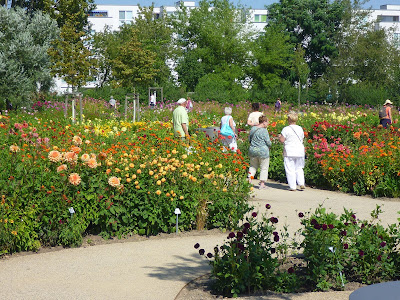In 1839, Johann Georg Christian Lehmann—the Director of the Botanical Gardens of Hamburg, Germany—named a newly discovered dahlia species to honor Heinrich Johann Merck [1,2]: Dahlia merckii it became. Merck was a merchant, lover of plants and senator of Hamburg (portrayed by Otto Speckter: Senator zu Hamburg, 1835).
While strolling through the Dahliengarten (dahlia garden) designed as part of the International Garden Exhibition in Berlin's Marzahn-Hellersdorf (IGA Berlin 2017), I came across an informative panel describing the naming of D. merckii as follows:
Dahlia merckii, like all dahlia species have Mexican (or northern South American) roots [3]. Soon after the first dahlias successfully grew from seeds that had been brought from Mexico to Europe, dahlias were cultivated and studied in gardens of the new continent (from a dahlia-geographic viewpoint). The scientific genus name, Dahlia, honors the Swedish botanist and Linnaeus-student Andreas (Anders) Dahl.
Keywords: horticulture, floriculture, dahlia species, scientific name, eponomy, taxonomy.
[1] Claudia Sewig: Dahlien und ihr Freundeskreis. Hamburger Abendblatt June 6, 2003. Link: https://www.abendblatt.de/vermischtes/journal/article106710562/Dahlien-und-ihr-Freundeskreis.html.
[2] Dahlia merckii: senador Johann Heinrich Merck. Asociación Mexicana de la Dalia o Acocoxochitl, A.C., February 28, 2015. Link: http://daliaoacocoxochitl.com.mx/blog_dalia-merckii-senador-johann-heinrich-merck.html.
[3] Martin Král: Of Dahlia Myths and Aztec Mythology - The Dahlia in History. Seattle, Washington, 2014. Link: dahlia.org/wp-content/uploads/2018/01/Dahlia-Myths-Part-1.pdf.
 |
| Dahliengarten (dahlia garden), Berlin 2017 |
One of about 35 species of the genus Dahlia is the Merck's Dahlia (Dahlia merckii). A few decades after Dahlia coccinea and Dahlia pinnata have been introduced to the European horticulture, seeds of the Merck's Dahlia reached the Hamburg Botanical Garden. The director of the Garden, JOHANN G. C. LEHMAN (1791-1860), soon realized that these seeds represent a new undiscovered species which he named in honor of HEINRICH J. MERCK (1770-1853), a well known Hamburg politician.
Dahlia merckii, like all dahlia species have Mexican (or northern South American) roots [3]. Soon after the first dahlias successfully grew from seeds that had been brought from Mexico to Europe, dahlias were cultivated and studied in gardens of the new continent (from a dahlia-geographic viewpoint). The scientific genus name, Dahlia, honors the Swedish botanist and Linnaeus-student Andreas (Anders) Dahl.
Keywords: horticulture, floriculture, dahlia species, scientific name, eponomy, taxonomy.
References and more to explore
[1] Claudia Sewig: Dahlien und ihr Freundeskreis. Hamburger Abendblatt June 6, 2003. Link: https://www.abendblatt.de/vermischtes/journal/article106710562/Dahlien-und-ihr-Freundeskreis.html.
[2] Dahlia merckii: senador Johann Heinrich Merck. Asociación Mexicana de la Dalia o Acocoxochitl, A.C., February 28, 2015. Link: http://daliaoacocoxochitl.com.mx/blog_dalia-merckii-senador-johann-heinrich-merck.html.
[3] Martin Král: Of Dahlia Myths and Aztec Mythology - The Dahlia in History. Seattle, Washington, 2014. Link: dahlia.org/wp-content/uploads/2018/01/Dahlia-Myths-Part-1.pdf.













